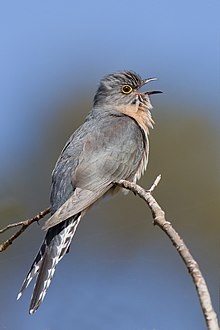Cuculinae
| Cuckoos Temporal range: Eocene - Holocene, 34–0 Ma |
|
|---|---|
 |
|
| Fan-tailed cuckoo | |
| Scientific classification | |
| Kingdom: | Animalia |
| Phylum: | Chordata |
| Class: | Aves |
| Clade: | Otidimorphae |
| Order: |
Cuculiformes Wagler, 1830 |
| Family: |
Cuculidae Leach, 1820 |
| Type species | |
|
Crotophaga ani Linnaeus, 1758 |
|
| Genera | |
|
Around 26, see text. |
|
Around 26, see text.
The cuckoos are a family of birds, Cuculidae, the sole taxon in the order Cuculiformes. The cuckoo family includes the common or European cuckoo, roadrunners, koels, malkohas, couas, coucals and anis. The coucals and anis are sometimes separated as distinct families, the Centropodidae and Crotophagidae respectively. The cuckoo order Cuculiformes is one of three that make up the Otidimorphae, the other two being the turacos and the bustards.
The cuckoos are generally medium-sized slender birds. Most species live in trees, though a sizeable minority are ground-dwelling. The family has a cosmopolitan distribution, with the majority of species being tropical. Some species are migratory. The cuckoos feed on insects, insect larvae and a variety of other animals, as well as fruit. Some species are brood parasites, laying their eggs in the nests of other species, but the majority of species raise their own young.
Cuckoos have played a role in human culture for thousands of years, appearing in Greek mythology as sacred to the goddess Hera. In Europe, the cuckoo is associated with spring, and with cuckoldry, for example in Shakespeare's Love's Labours Lost. In India, cuckoos are sacred to Kamadeva, the god of desire and longing, whereas in Japan, the cuckoo symbolises unrequited love.
...
Wikipedia
